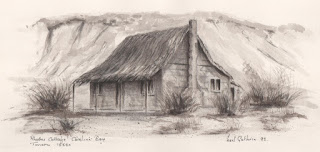Mona Vale School
1996
This
delightful little school still stands at Mona Vale, a locality west of the Main Highway between the townships of Cave and Albury. Its construction was initiated during the early
part of the twentieth century by a group of residents living in and around the
Ma Waro district and led by William Tasman Smith.
It
appears that the name Mona Vale came about when William’s father, A. B. Smith
purchased about 1200 hectares of land from the Rhodes
family, who at that stage owned Levels Estate.
Although
born in Scotland , William
Smith had spent some time in Tasmania prior to
arriving in New Zealand and
was familiar with a famous property in Tasmania
It
is reported that on February 13. 1912.
Education Board Representatives held a meeting with householders in the Ma
Waro district. It was resolved that a
new school be built on what is now Mona Vale Road, adjacent to Coal Creek and
suitable of accommodating 30 children.
William,
or as he was more commonly known, Tasman Smith, stated at that meeting, if the
school could be built of limestone, he would donate all the stone required to
the school from his own property.
April
30th. 1912, tenders for the erection of a school were received.
Tenders for the stonework were received from;
John Finn. __One hundred and fifty five
pound
Harding and Roy. __One hundred and seventy
two pounds, nineteen shillings
A plumbing tender was received from;
A. Cooper. __Eleven pound, eight shillings
Croxford and Co. __Thirteen pound, thirteen
shillings
Joinery tenders came from;
Hadley and Clough. __Fourteen pound, eight
shillings
Shillito Bros. __Twenty three pound,
eighteen shillings and six pence
Jacksons Ltd. __Twenty four pounds,
seventeen shillings
J. Murdock. __Twenty five pounds
Westland Timber Co. __Thirty five pound,
four shillings and nine pence
John
Finn won the contract for stonework on this new school and under his direction
construction began within a few weeks.
I
am led to believe, John lived only a few miles away, down by the Te Ngawai
River. Yet for the duration of the
contract it is recorded he obtained board and lodgings near the site, with Mr
and Mrs Hogg.
John
was actually born in Blencowe ,
Cumbria New Zealand
One
can easily see from his work on the school, even after all those years, John Finn
was a perfectionist. He dictated the
quality of stone to be used coming from Tasman Smith’s quarry, about two miles
further up the valley. Each teamster, in
charge of a Clydesdale horse and a tip dray, carted the raw limestone down a
rough shingle track to the site.
Harry
Blisset, an old identity of the district, was one of those teamsters on the site;
he must have been in his early twenties at that stage. I knew
Harry when he was getting on in years, living in Pleasant Point with his wife
on Te Ngawai Road .
February
1st 1913 was a very special occasion in the Ma Waro district; the
new Mona Vale School
Twenty
children arrived at the gate that first morning, ready for their first lesson
under the guidance of Miss Vida Sutherland.
Vida was employed in the interim, until a permanent teacher was
available. On May 13, applications were
received from prospective teachers to fill a full time position at Mona
Vale. Mrs Culprit, Misses McClellan, Bailey
and Scannell all applied. However, it
was Miss Scannell who was appointed. Miss Anderson acted as headmistress, until
Miss Scannell arrived.
By
1920 the School had increased to twenty seven pupils, teacher in charge at the
time was Miss Florence Tizard. She
boarded Monday to Friday, with a parent nearby.
At the end of each school week she would walk the several miles to the
Ma Waro railway station where she caught the Friday evening train to Timaru for
the weekend, returning on Monday morning.
Some
Children attending school during those early days were lucky enough to have a
pony to ride, yet many others had to make do with a good old Shanks’s pony (walk).
Many
a school day during the summer was spent in the spring fed swimming pool up the
valley. Pupils continued their lessons
in the shade of the trees, as well as being taught to swim. Some of the highlights throughout each year
were the school concert, the annual pet parade and a trip to the Albury Flower
show. Of course some of the most
exciting times were to be had at the nearby Coal Creek, here the kids could
tickle a trout, try their hand at bird nesting or spear an eel with dads garden
fork.
Sadly
though, with the declining roll in the early 1940’s, the school faced a very
uncertain future. Then at the end of
term 1944, with the school roll of just five pupils, the Education Board closed
the Mona Vale School
When
I was last by there several years ago, the building was well maintained,
obviously by a dedicated community for regular community functions.



Comments
Post a Comment